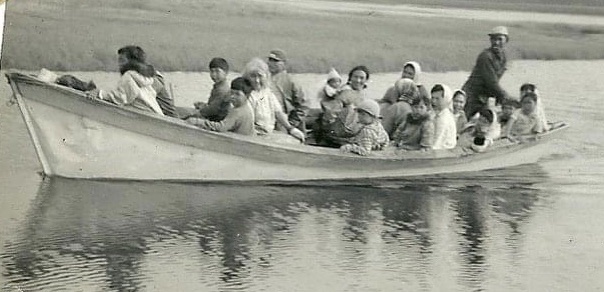Village Life Stories: Shareholder Alyce Walluk
“I was raised the Inupiaq traditional lifestyle during the early 1950s on the Seward Peninsula between the villages of Wales and Mary’s Igloo, Alaska. After moving to Teller in 1959, our family would travel up the coast for springtime subsistence hunting, fishing and gathering by dog team pulling a boat with all the things we needed for camping during the month of April. My mom was from the coastal village of Wales and my Dad from the inland village of Mary’s Igloo. The people from Mary’s Igloo relocated to the town of Teller sometime during the 1940s, so no one lives there now.
We used a white-walled canvas tent for living quarters, and usually an oil drum cut in half for heat and a primer camp stove for cooking. We camped with people from Brevig Mission, Alaska.
The men and women hunted for walrus, seals, fish and sometimes whale to be prepared for oil, blubber, dried and fresh meat. The food was preserved in seal oil using sealskin pokes or wooden barrels.
For entertainment, we played Eskimo baseball, an old traditional game called “Mana, Manaa,” string games, playing lap games with babies and children using all the resources (seashells, rocks, wood, empty cans, etc.) for toys.
During the month of June, when the ice broke up, we headed for the Tuqshuk channel (river east of Teller) by boat to our family’s campsite to fish and gather all types of greens (vegetables.) The people of Brevig also went to their camps or back to their village. Once again we dried the fish or ate it cooked half-dried or freshly cooked. The greens are usually preserved in seal oil, and cooked in water. Around this time my Dad’s brother who had a reindeer herd held a yearly round-up at a place called Plant which is located off Grantley Harbor near Teller.
In July we’d go further up the river, which is off the Imagruk Basin to fish, hunt for ducks, caribou, reindeer and other land animals, gather more greens and pick berries. The berries are stored in barrels or other containers or eaten fresh. The berries we picked first are salmonberries and blueberries, and in the fall are the blackberries and cranberries. We usually returned to the town of Teller by October for the winter and to go the school.
My first language was mostly Inupiaq which was spoken by all the adults. We learned English just before we started school. When I was a child, my mom spoke in Inupiaq and gradually learned to speak in English from her children.
BSNC’s Village Life Stories Project is an initiative to share the Bering Strait region’s rich cultural history and the lifestyle of Our People. BSNC shareholders and descendants are invited to submit stories of personal experiences about growing up and life in the village to media@beringstraits.com. Photos are not required but are encouraged. Story entries must be accompanied by the author’s name, hometown and a story title. Selected stories will be shared on BSNC’s website and social media accounts. Submit stories to media@beringstraits.com.

